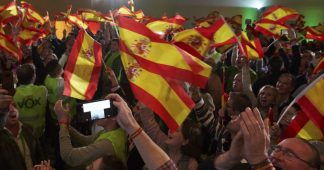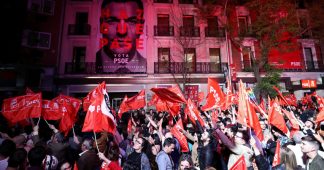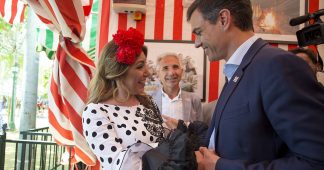In the late 2000s the Dutch Socialist Party was a success story, having risen from a small Maoist group into a 50,000-member party. But a split with its youth wing and talk of a coalition with right-wingers have demoralized activists — and shown the dangers of a parliamentary party becoming unmoored from labor and social movements.
By Alex de Jong
Jan.18, 2021
Around the turn of the millennium, the SP opened up to social movements and established itself as a reference point for left-wing activists. Its membership grew rapidly, and by the late 2000s, it had 50,000 members — twice as many as 10 years before. In 2006, it won over 16 per cent of the vote.
Yet despite the SP’s past successes, today its prospects do not look good. With the Netherlands set for a general election in March, the SP is divided, and uncertain on how to reverse its recent decline.
Declining Appeal
The mood among many SP activists is pessimistic. Membership has declined by 18,000 in the last ten years, and the party’s support in national elections has fallen below 10 percent. Only four months before March’s elections, the SP leadership cut off support to the party’s youth-wing, ROOD, accusing it of being infiltrated by communist radicals and breaking party rules. This was preceded by expulsions of a number of activists who were accused of being members of the Marxist Forum and/or Communist Platform, two groups active inside the SP that the leadership labelled “rival” political parties.
Dissent against such measures is widespread — and at the congress where the SP adopted its program for the coming elections, over a third of the party voiced its opposition to these steps. This conflict between the leadership and ROOD deepened existing disagreements over assessments of the SP’s downward trajectory over recent years, how it can recover, and what its priorities should be.
In this sense, the SP faces questions similar to those faced by other parties to the Left of social democracy, such as what alliances and compromises can benefit socialist politics in the long term — and in what conditions a socialist party can assume a role in government. In this case, the conflict between ROOD and the party leadership escalated when the youth organization published a statement declaring its opposition to the SP entering a governing coalition with the Right.
Given the large number of parties represented in parliament, Dutch administrations traditionally consist of coalitions of multiple different parties that together form a majority. The current SP leadership has declared that it is willing to consider coalitions with right-wing parties in hypothetical future governments, including with prime minister Mark Rutte’s secular, free-market VVD. The SP has already joined the VVD in local-level executives and recently broke with the other left-wing parties to support a controversial environmental law proposed by the administration.
Understanding what is happening inside the SP can be difficult. The party has a notoriously top-down structure, partly inherited from its Maoist days, and factions and organized currents are banned. Moreover, as the party’s involvement in executives and city councils grew alongside its own apparatus, full-timers that often double as elected representatives and staffers increasingly concentrated information and decision-making in their own hands. The lack of a party-wide debate or involvement of the rank and file mean that party policies can be decided by small, informal groups.
The party’s position on participating in a government coalition is an example of this. A recent motion holding that there a should be a debate in the SP over this issue was rejected with the argument that it was “too early” for such a discussion. But shortly after this, the leadership changed its position without discussion, as it moved from opposing a coalition with the VVD to accepting it as a possibility.
Elections and Social Movements
The recent disappointments have produced what we can broadly outline as two different groups among SP leaders.
One insists on presenting the party as a reliable partner in government for forces to its right. As part of this approach, the SP already some years ago entered local-level executives such as in Amsterdam, where it joined with parties of the Right in a coalition excluding the Labour Party. Another group of SP leaders, though not opposed in principle to such coalitions, nonetheless insist on a more activist profile for the party and adopt a more traditional socialist rhetoric.
The disagreement between such “coalitionists” and “activists” is essentially a matter of how the SP should present itself to voters; as a “responsible” party fit for government and operating within the constraints of establishment politics, or as a party of dedicated, oppositional activists.
The most prominent “coalitionist” is Lilian Marijnissen, the chair of the party’s parliamentary caucus. She is the daughter of Jan Marijnissen, the long-time party leader under whose leadership the SP became a national force. An important representative of the “activist” approach was Ron Meyer, the party’s former chairperson. Meyer, who was previously a trade-union organizer, left his position in the party after the failure of its European election campaign in 2019.
But despite their differences, both groups are focused on elections as the way out of the SP’s predicament. Building independent social movements as goals in themselves or as part of a long-term strategy are not part of the vision of either group.
In fact, many SP activists feel that the party’s current orientation is isolating it from social movements. This has become especially pronounced in regard to mobilizations around racism and climate change. The SP was always weak on the issue of anti-racism, seeing it as a side issue, but its ignoring of anti-racism has become more and more obvious as the issue has grown in importance in Dutch politics.
The Dutch far-right has grown dramatically, feeding and encouraging Islamophobia and other forms of racism. In response, the country saw significant anti-racist mobilizations and increased political debate around racism. But the SP plays little to no role in such developments. In educational materials the SP counterposes what it calls “race struggle” to “class struggle.” Significant protests that attracted many young people have also taken place around the issue of climate change, but here as well the party remained aloof. Participation is left largely to decisions of local chapters, and to ROOD.
For many, concerns over racism and climate change are the beginning of a broader politicization — but joining the current SP would not appear to them as a logical option.
When the SP stands apart from such mobilizations, this is not for lack of means. Rather this is a strategy, motivated by the prioritizing of electoral results and a calculation of what the party leadership thinks will bring in most votes. Anti-racism and climate-change measures are assumed to be too “controversial” among (potential) SP voters.
Former SP councillor Mahmut Erciyas describes this strategy as trying to “combine progressive social-economic policies with cultural conservatism.” Party members complain that marketing agencies and public relations experts have had more of a say in determining this course than rank-and-file activists. When members succeeded in having anti-racism declared a priority at a recent party congress, this had little practical follow-up.
Erciyas was for years a councilor in the city of Oss, one of the SP’s bastions, and the city where Lilian and Jan Marijnissen started their political careers. Oss is a typical SP stronghold: a medium-sized city in the formerly Catholic south of the country, with a predominately white population and without a strong left-wing tradition.
Dissatisfaction over the current political orientation of the SP is especially strong in the larger, more racially diverse cities, such as in Rotterdam (the country’s second largest) and Amsterdam.
“The current political orientation of the SP is a dead-end, it does not connect with the diverse reality of the working class, especially as it exists in the larger cities,” says Erciyas.
Other SP activists criticize the orientation of the leadership in similar terms, saying it is trying to address a caricatured, outdated version of what is only one segment of the working class. With proposals such as requiring working permits for people from other European Union countries, the SP is “repeating the mistakes we made towards Turkish and Moroccan labor migrants,” says Ercias. “We are attempting to keep Polish workers out, instead of strongly supporting them in their struggle for a better life.”
Among trade unionists, the SP is, along the Labour Party, one of the most popular parties, but here as well the party is not a strong, organized force. The SP dissolved its shop-floor structures years ago.
According to Gus Ootjers, one of the expelled SP members, the party passes up an opportunity to organize working-class supporters. “There are plenty of SP members who are also active trade-unionists, but the party-leadership does not want to develop a trade-union strategy. The party is not involved in developments and discussions in the trade-union movement, and then complains its orientation is too right-wing.”
A Failing Strategy
The prioritizing of electoral results and avoiding controversial questions means the party seems not to have a clear stance on central political issues. The SP’s attempts build a political profile through its own campaigns, such as around health care, have not been as successful as hoped and were folded into electoral work. Already in 2006, programmatic points of the SP that were considered to be “deal-breakers” for possible government participation, such as republicanism and NATO membership, were removed from the party’s election programs. The recent expulsions are a further step to integrate the SP into establishment politics.
One issue on which the SP does take a clearly different position concerns the European Union. The SP warns of a “European superstate” and demands the return of a Dutch national currency. Yet it has no alternative vision for international left-wing cooperation and attention to international developments is limited. The SP never joined the European Left Party, including forces like Germany’s Die Linke. Rather, the SP leadership emphasizes the Dutch nation-state as its political framework.
In this vein, ahead of 2019’s European elections the SP attempted to appeal to, in the words of its former European Parliament member Erik Meijer, “the angry outsiders;” people who would otherwise abstain or vote for Geert Wilders’s far-right, anti-EU PVV. But its attempts to mobilize anti-EU sentiments were not successful and it lost the two seats in the European Parliament it had held since 2004.
Support for the bid to present the SP as a potential coalition partner by toning down its demands comes, in part, from members who have participated in local and regional executives in recent years. But such pressure also comes from ordinary voters and members. This only logical, since the SP does not present any long-term goals other than seeking good election results and joining executives with the capitalist parties.
It remains unlikely that the SP will actually join a government coalition after March’s elections. Rather, the leadership’s emphasis on its willingness to do so is based more on the assumption that such rhetoric is needed to come across as an acceptable choice.
Decisions such as declaring the SP is willing to cooperate with the traditional enemy of the Left, the VVD, or abstaining from social movements and treating activism as an electoral campaign tool, flow from the party’s electoral orientation. This has led to dissatisfaction and frustration among its activists. In the last decade, membership declined by more than a third, and the recent conflicts led to more resignations of angry and disappointed members.
Changed Terrain
Even on its own narrowly electoral terms, the SP’s strategy is not working. And the difficulties it faces go deeper than what can be solved by a successful election campaign or public relations experts. The political climate has grown more conservative. Despite mishandling the COVID epidemic, current prime minister Rutte remains very popular.
There are also other changes to which the party should respond. The coming post-pandemic economic crisis will lead to new rounds of austerity while trade-union membership is declining strongly. The most important trade-union federation FNV lost seven per cent of its members in 2019. Of all EU countries, Netherlands has one of the highest percentages of workers in precarious conditions. But the unions are failing to attract young, precarious workers.
Yet even while the weight of the trade unions has declined, new social movements have arisen around racism and ecology, and people of color have become more politically organized in response to racism and the far-right. The SP’s avoidance of important social mobilizations, its rigid structure and hostility to open debate leave it unappealing to newly politicizing activists. Inside the party, critical members fear the SP will lose connection to younger activists. The fight with ROOD is a dramatic illustration of that risk.
In the past, the SP’s successes provided legitimacy to the leadership. But as its fortunes have waned, dissatisfaction and opposition have only risen. Some are considering voting in March for the new anti-racist party Bij1 (“together” in Dutch pronunciation) which also has a strongly leftist economic program. Radicals in the SP are arguing that despite everything, people should remain in the party and attempt to change its course.
ROOD is continuing its activities, while demanding that the party-leadership restores the links with the youth organization. Party members have started a campaign for financial aid to ROOD and also call for the links between the organizations to be restored.
Radicals in the SP plead for an orientation that prioritizes opposition in and outside of parliament, and an independent agenda. For this, active involvement in social movements, and the formulation of political positions that incorporate the issues of the movements and working-class demands are needed.
This can only be successful if the SP works along and with other forces. In recent years, the SP has become, in the words of one activist, “a problem-solving party,” focused on responding to political issues but lacking in alternatives of its own and a long-term vision. But considering the limited visibility of socialist ideas in the Netherlands, ideological struggle over what society should look like is urgently necessary.
The Netherlands is no exception to the global pattern, whereby eruptions of anger lead to mobilizations which may then dissipate with little trace. This poses the need to build what Alan Sears has called new “infrastructures of dissent,” “the amalgam of spaces, networks and institutions in which activists develop their capacities to push back against the capitalist austerity consensus and the narrow frame of official politics.” Rather than trying to appeal to a supposedly existing constituency (which as election results are showing is limited), the party needs try to win people over to a different vision.
It is clear that if the SP persists in its current course, further isolation and decline are unavoidable. Forcing changes in orientation will be a difficult struggle. Considering the structural weakness of the Left, there is no guarantee of success
Published at jacobinmag.com











